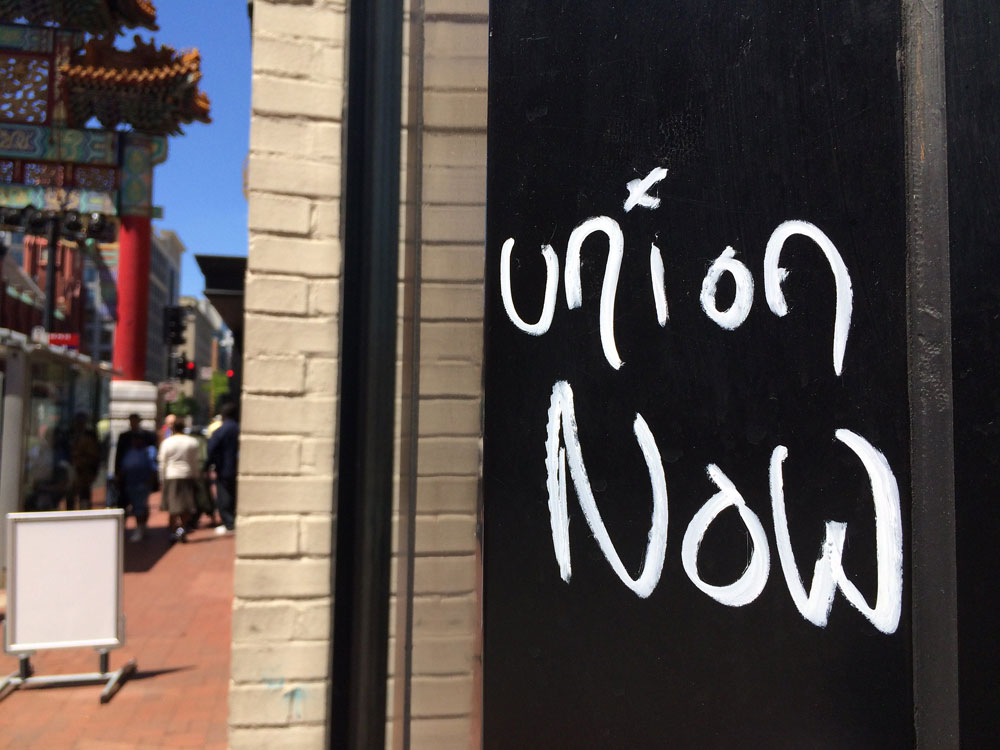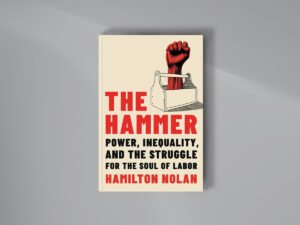

Earlier this month, in an article on pending antitrust legislation, NPQ profiled Amazon’s growth from a business perspective. Nationally, Amazon sells 49 percent of all new books by unit, and controls 72 percent of all adult new book sales. They hold 32 percent of the cloud computing market and 70 percent of the voice assistant market. When Americans seek to buy a product online, 49 percent turn to Amazon first.
But another aspect of Amazon’s increasing influence is as an employer. As its operations expand, Amazon hires more and more people, as Erika Hayasaki details in the New York Times. Amid the pandemic, Amazon has hired 400,000 new workers and now tops a million employees in the US and 1.3 million worldwide. No other company in US history has added so many workers in a single year.
Among US companies, only Walmart, with 1.5 million workers in the US and 2.2 million around the globe, employs more people. Like Walmart, Amazon’s workforce is nonunion—and whether Amazon workers opt to unionize could tell us a lot about the shape and future trajectory of the US economy.
One place where Amazon is making its influence felt as an employer is in the Inland Empire region of California, an area east of Los Angeles that’s home to 4.6 million people and comprises San Bernardino and Riverside counties. In 2012, Amazon employed 3,000 people in its first regional warehouse there. Today, Amazon has 14 facilities and two air hubs in the Inland Empire and employs over 40,000 people, with 8,000 added during the pandemic. In some parts of the region, Hayasaki adds, aspects of Amazon’s control parallel the company towns of yore, such as General Motors’ dominant position in Flint, Michigan in the 1930s.
Another community feeling Amazon’s impact is Bessemer, Alabama—a small, majority-African American (72 percent) city of about 26,500 people, located about 16 miles southwest of Birmingham. Amazon opened a warehouse there less than a year ago, and, as we write this, a union mail-ballot election involving 5,805 warehouse workers is under way. Voting began February 8th and will end on March 29th.
Workers in this election will determine if they will be represented by the Retail, Wholesale, and Department Store Union (RWDSU), which is affiliated with the United Food and Commercial Workers. The RWDSU currently represents an estimated 18,000 workers throughout Alabama, including 12,000 poultry workers. It’s a union with a storied past and activist present, as Caitlin Harrington details for Wired:
Workers at the Bessemer facility began organizing shortly after last summer’s Black Lives Matter protests, highlighting the pandemic’s disproportionate harm to people of color. Upwards of 80 percent of the Bessemer workers are Black, and the majority are women, and the RWDSU framed the campaign as a civil rights issue. The union has had Black leadership since its founding in the 1930s, a time when some unions excluded Black workers, and its members organized alongside Martin Luther King Jr. during the 1963 March on Washington. In 1968, the union became the first to secure a contract designating King’s birthday a paid holiday.
The union election in Bessemer is also the first one involving Amazon workers in seven years. While 5,800 workers are a small percentage of Amazon’s workforce, Amazon employs hundreds of thousands of warehouse and delivery workers, and the Alabama vote is seen as having ramifications across the company and beyond.
To understand what is at stake, a quick review of the financial numbers helps. Last quarter, Amazon generated $125.6 billion in sales, the first time it had ever topped $100 billion. Annual 2020 revenues were $386 billion, a 38-percent increase over 2019. Company profits were $21.33 billion, an 84-percent increase from 2019. Based on these numbers, CEO Jeff Bezos has seen his net worth increase to about $185 billion. In 2020, Amazon generated a profit in excess of $16,400 per Amazon worker.
Nationally, of course, union numbers have been falling for some time now. Once, 35 percent of US private sector workers were union members. Now, that number stands at a paltry 6.3 percent, and the only reason why overall unionization rates in the US remain in double digits is due to the strength of public sector unions.
Back in 2018, NPQ pointed out the existence of a strong correlation between union strength and the equitable distribution of income—and, conversely, the relationship between union weakness and income and wealth inequality:
Broadly speaking, if one looks at the economics of the period spanning from 1945 to the present, it is clear that the United States has experienced two markedly different periods within the past seventy-plus years. The first era—the one that coincided with a relatively strong labor movement—was marked by a relative degree of economic equality; this began to shift, however, in the 1970s, and the period of 1980 to the present has been marked by rapidly rising inequality.
Of course, correlation is not causation. But the causal mechanism of how unions equalize power in the economy is not exactly a mystery. Back in the mid-20th century, economist John Kenneth Galbraith outlined how unions serve as a “countervailing” force that pushes back against corporate power and helps ensure workers take home a greater share of what they produce. Corporations like Amazon, now largely shielded from that union brake, keep more for executives and company shareholders. Indeed, that is what one might expect profit-maximizing companies to do.
Sign up for our free newsletters
Subscribe to NPQ's newsletters to have our top stories delivered directly to your inbox.
By signing up, you agree to our privacy policy and terms of use, and to receive messages from NPQ and our partners.
The results for society absent that union voice, however, are dire, reducing workers’ overall share of national income by four percentage points since 2000. As a result, wages are, economy-wide, thousands of dollars a year per worker less than they would be had worker incomes tracked national growth. Back in 2018, Federal Reserve chair Jerome Powell called this outcome “very troubling.”
While Amazon, partly due to pressure from US Sen. Bernie Sanders (I-VT), now offers base pay of $15 an hour, working conditions at its warehouses are often poor. Hayasaki observes, “Many of the jobs [are] physically demanding, with quotas dictating output. Some workers skip bathroom breaks or suffer injuries in order to scan upwards of 300 items per hour. The positions come with health benefits and a 401k, but employee turnover is so high that many people don’t make it long enough to collect.”
Brian Freeman, a workers’ compensation lawyer in the Inland Empire who has represented 78 Amazon employees, describes some of the working conditions to Hayasaki: “They are reaching down for boxes all day, bending in ways they are not used to, and all of a sudden—bam. They break. Their neck, their back, their arms, something goes out.”
Data on serious injuries at over 150 Amazon warehouses in 2019 compiled by Reveal and the Center for Investigative Reporting find injury rates at Amazon warehouse facilities are often well above the industry average of four serious injuries per 100 workers, with over a fifth of Amazon facilities having a serious injury rate of 10 percent or greater. The Eastvale facility in the Inland Empire that Hayasaki profiles is among the worst; its serious injury rate in 2019 was 18.9 percent.
There are also the daily violations of worker dignity. Darryl Richardson, a pro-union worker at the warehouse in Bessemer, tells Washington Post reporter Jay Greene about the high-pressure environment that prevails. Bathrooms, he explains, are often a long walk away in the large warehouse facility and there is constant pressure to be on task.
As Harrington details, “Cameras blanket the warehouses, and the company’s Time Off Task (TOT) system tracks every second workers aren’t picking, packing, and stowing to meet quotas, or ‘make rate.’ Too much TOT is grounds for termination. Workers fear that if a family member falls ill or some bad lunch meat necessitates extra bathroom breaks, that could be it for their job.”
Alabama is not known as a union stronghold, but, as Harrington explains, Bessemer is a bit of an exception in that regard. The Birmingham suburb was once home to a number of steel mills. (Amazon’s facility is actually located on the site of what was once a mill owned by US Steel.) And the Bessemer workers are gaining public support. Former Georgia Democratic gubernatorial candidate Stacey Abrams is among those who voiced their support for the workers’ campaign. “You deserve the dignity and well-being that a union can help provide, allowing you to care for yourself and those you love,” Abrams said in a video recording this past Saturday.
For its part, Amazon is going to extraordinary lengths in its efforts to defeat the union drive. Labor reporter Mike Elk reports that this past Sunday evening, “Workers throughout the plant received emails offering them bonuses if they simply quit their jobs. The emails offer workers, who worked for two peak seasons, at least $2,000 to quit. If workers have been there at least three peak seasons, they are offering them $3,000.” He adds, “Workers are even being told that if they quit now that they could regain their jobs later after the union election.” Of course, workers who quit are ineligible to vote in the union election.
Elk observes that, were the union to lose the election, tactics like this “could be grounds for the union to petition the National Labor Relations Board (NLRB) to order a new union election if RWDSU loses this round.”
There is, it should be noted, a long history of union organizing in the South, with defeats more common than victories. A 2017 vote at a Nissan plant in Canton, Mississippi provides one recent example. But union organizing is difficult throughout the US. One key reason why so few people join private-sector unions today is that the law makes it exceedingly difficult to do so. As Harrington points out, “The US National Labor Relations Act (NLRA) allows only what’s called enterprise-level bargaining, meaning unions must organize on a workplace-by-workplace basis.”
Patricia Campos-Medina, codirector of Cornell University’s Worker Institute, tells Harrington, “Every time there’s a challenge, the entire corporation puts its massive resources into defeating the union drive. Until we change that framework, every time workers deal with a massive corporation, they are going to be the underdog.”
Can the Amazon workers of Bessemer beat those odds? It is impossible to know until the ballots are counted. But maybe this time is different. Union president Stuart Appelbaum tells Hayasaki that workers in Alabama signed union cards because they were “fed up with how they were being treated, their basic humanity.” Joshua Brewer, an RWDSU organizer, tells Harrington that if the union prevails, “it will be because grandparents and uncles and parents talked to these young folks who work out here and said, this helped me, and it’s a good thing.”
While the election is taking place in Bessemer, the movement of Amazon workers fighting for their rights is widespread and national. This means, across the country, workers at Amazon—and beyond—will be watching.













